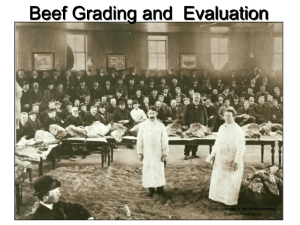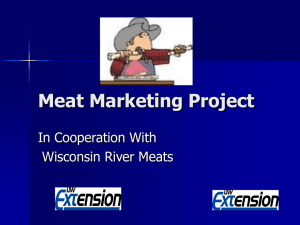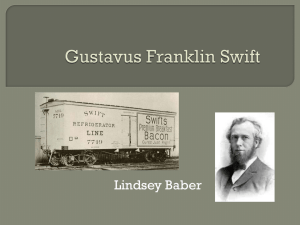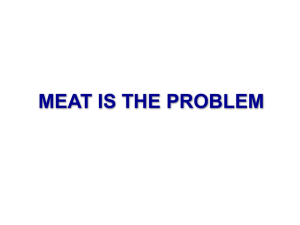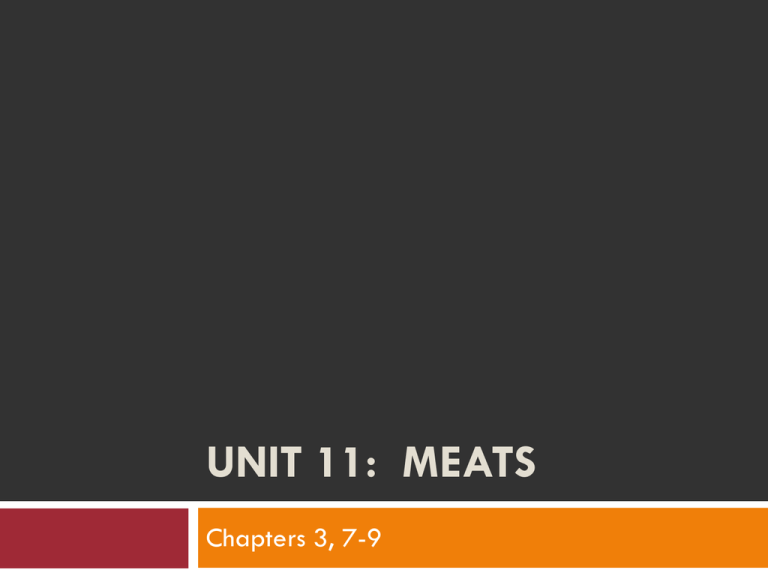
UNIT 11: MEATS
Chapters 3, 7-9
Objectives
Understanding of where meats come from
Knowledge of Grading meats
Appreciation for live animal meat evaluation
Knowledge of various cuts of meats
Understanding of animal by-products and their
places in the industry
Sources of Red Meats
Beef-from cattle > 1 yr. of age
Veal-calves from 3 mos. or younger
Pork-swine
Mutton-mature sheep
Lamb-young sheep
Chevon-goats (goat meat)
Figure 9.4
Location of the wholesale cuts on the live steer, pig, and lamb. Source: Colorado State University.
World Supply
~3.5b lbs.
Red meats accounts for over 85% of all production
U.S., China, Russia main suppliers
U.S. production of beef & pork >50b lbs.
Products
Use CO2 or stunning to render animal unconscious,
cut jugular before removing hide/scales
Drop separated from carcass
Head
Hide
Hair
Shanks
Organs
Products
Dressing percentage
Carcass
wt divided by live wt * 100
Average dressing percentages
Hogs
– 72%
Cattle – 60%
Sheep – 50%
Factors
affecting dressing %
Fill
Fatness
Muscling
Wt
of hide
Wt of wool
Products
Beef/Pork carcasses are split down the backbone
into halves
Can
be stored in a cooler 28-32F
Can be stored several weeks, most are only a day or
two
Larger
companies move meat faster
Small packers may allow meat to age and tenderize
Products
Shipping meats
Used
to ship in carcass form
Today, most packers process into wholesale/primal cuts
or even to retail cuts (boxed meats)
Figure 3.1
Annual commercial red meat production by type of meat. Source: Livestock Marketing Information Center.
Figure 3.2
Center.
Commercial cattle harvest in the United States, 2005 (1,000 head). The top 10 states are circled. Source: Livestock Marketing Information
Figure 3.3
Commercial hog slaughter 2005 (1,000 head). Source: Livestock Marketing Information Center.
Kosher & Muslim Meats
Specific rules for the slaughter of religiously
acceptable animals
Kosher meats
Comes
from animals w/ split hooves, chew cud,
slaughtered according to Jewish Law
Also prohibitions against mixing meat/milk
Can only be slaughtered by specifically trained persons
Must not eat blood, or parts containing blood…specific
arteries & veins must be removed
$100 m in sales each yr in U.S.
Kosher & Muslim Meats
Any Muslim may slaughter an animal
Can
also be slaughtered by others while approved
people present
Composition
Physical
Lean,
fat, bone, connective tissue
Proportions change over time
Chemical
65-75%
water
15-20% protein
2-12% fat
1% minerals
What happens to these ratios as the animal gets older?
Figure 3.8
The fundamental structure of meat and muscle in the beef carcass.
Nutritional Considerations
Nutritive Value
High
nutrient density foods
High in vits, mins, iron, protein, essential amino acids
Research focused on development of more, new cuts of
meat to increase consumption, health benefits, etc.
Consumption
Consumed for both satisfaction & nutritional content
Actual consumption data difficult to collect due to
variation in cuts, waste amounts, etc.
Changes in prices of meat products results in shifts in
demands back and forth from poultry and red
meats
Figure 3.10
Annual U.S. red meat and poultry consumption (boneless weight). Source: Livestock Marketing Information Center.
Figure 3.11 Daily per-capita meat consumption as part of meat, poultry, fish, dry beans, eggs, and nuts group (Food Guide Pyramid). Source:
National Live Stock and Meat Board.
Demand
Seems to be better barometer than per-capita
consumption
Price at which consumer will buy a specific
quantity…all other factors being equal
Drives not only meat purchases…but the livestock
population numbers on the farm
Figure 3.12
Annual retail meat and poultry prices (Nominal basis). Source: Livestock Marketing Information Center.
Figure 3.15
Annual per-capita U.S. expenditures for meat and poultry. Source: Livestock Marketing Information Center.
Marketing
Terminal markets
Large,
livestock collection centers
Sale Barns
Located
all across the U.S.
Purchased on live weight basis, buyer estimates value
of the carcass
Grade and Yield
Some
animals purchased on carcass merit basis
Cuts out the middle man to some extent, but also lower
the live weight market price
Marketing
Interesting facts:
½
of all food taken home to be prepared
½ of white collar workers eat 1 meal/d at their desk
¼ of calories consumed in form of snack foods
10% of all food consumed in a vehicle
Consumer confusion regarding what meat to purchase
and how to prepare it
¾ of consumers have no evening meal plan at end of
the day
Marketing
Shifts
Mid
in consumer preference changes producer goals
80’s demand for leaner meats
Producers changed genetics, feeding, etc.
Resulted in loss in sales due to loss of taste
Only when producers matched leanness and marbling did
consumption begin to rise
Market Classes & Grades of Livestock
99$b of meat products are marketed annually
Market Classes and Grades
Segregates
animals, carcasses, and products into
uniform groups based on buyer and seller preferences
Established by USDA, but not mandatory
Most
comply
Meat inspection is mandatory
Market Classes and Grades
Slaughter Cattle
Veal
1-3 mos. <150 lbs.
Calf 3-10 mos. 150-300 lbs.
Beef >12 mos. Carcass wt. >300 lbs.
Also separated by sex classes
Heifer,
cow, steer, bull, bullock, stag
Separates carcasses into more uniform wts.
Market Classes and Grades
Quality
Grades
Measures
consumer palatability characteristics.
Maturity
Observed by bone/cartilage structures
Marbling
Intramuscular fat, or flecks of fat within the lean
Evaluated at the exposed rib-eye muscle between 12th and 13th
ribs
10 degrees are established from abundant to devoid
Figure 8.1
USDA quality grades (Commercial, Cutter, and canner omitted). Courtesy of USDA.
Figure 8.3
Relationship between marbling, maturity, and carcass quality grade. Source: USDA.
Figure 8.4 Exposed ribeye muscles (between the 12th and 13th ribs) showing various degrees of marbling associated with several beef carcass
quality grades. Courtesy of the American Meat Science Association copyrighted 1997.
Figure 8.5
Location of the fat measurement over the ribeye (longissimus dorsi) muscle. Source: Colorado State University.
Market Classes and Grades
Yield
Grades (aka cutability grades)
Measures
quality of boneless, closely trimmed retail cuts
from major wholesale cuts of beef (round, loin, rib, chuck)
Yield Grade
% BCTRC
1
> 52.3
2
52.3 - 50.0
3
50.0 - 47.7
4
47.7 - 45.4
5
< 45.4
Figure 8.2
USDA yield grades for market cattle. Courtesy of USDA.
Figure 8.7
The five yield grades of beef shown at the 12th and 13th ribs. Courtesy of American Meat Science Association copyrighted 1997.
Figure 8.8 Quality grades and yield grades of beef, 2004. Note: Approximately 10% of total carcasses are not quality or yield graded,
respectively. Quality and yield grade percentages do not equal 100% due to rounding error. Source: USDA.
Market Classes and Grades
Feeder Cattle
Feeder
grades used to predict wt gain & slaughter wt
end point of cattle fed to a desirable fat-to-lean
composition
Two criteria
Frame
size
Thickness
Figure 8.9
The three frame sizes of the USDA feeder cattle grade system. Source: USDA.
Figure 8.10
The four thickness standards of the USDA feeder cattle grade system. Source: USDA.
Carcass Composition Display
Preferred proportion of fat:lean has changed over
the years
How/Why?
Yield Grades determined from 4 carcass
characteristics:
Amount
of fat in .1” over the rib-eye muscle
Kidney, pelvic, heart fat
Area of the rib-eye muscle in sq. in.
Hot carcass wt.
Carcass Composition Display
Quality and Yield grading is voluntary, however,
about 90% is quality graded, and 84% is yield
graded
Carcass Composition Display
Slaughter Swine
Sex
Classes
Barrow,
gilt, sow, boar, stag
What is the difference?
Traditional
grades for Barrow/Gilt carcasses based on
two characteristics
Quality
of the lean
Expected combined yields of for lean cuts:
Ham
Loin
Blade Shoulder
Picnic Shoulder
Carcass Composition Display
Two
quality grades for lean in pork carcasses:
at the exposed surface of a cut muscle at the 10th
and 11th ribs
Acceptable
Observed
Gray/pink in color
Fine muscle fibers
Fine marbling
Graded 1-4 depending on the amount of lean
Unacceptable
Too dark/pale
Soft
Watery
Bellies are too thin for bacon
Visual Perspective of Carcass
Composition of the Live Animal
Goal: large amounts of highly palatable lean w/
minimal amounts of fat & bone
Sizes and shapes of cattle, swine, sheep are
different, but muscle structure and fat deposition
areas are almost identical
Ex.
Animal w/ square appearance over top of back,
block and deep from the side has a large accumulation
of fat
Visual Perspective of Carcass
Composition of the Live Animal
Fat accumulation
Brisket
Dewlap
Jowl
Between
hind legs
Edge of loin
Behind the shoulders
Shoulder blade movement can be seen when lean
cattle/swine walk
Visual Perspective of Carcass
Composition of the Live Animal
Animals w/ oval shape to its back and thickness
through the center of hind legs have high proportion
of lean:fat
Fat on retail cuts has been reduced over the last 20
years
1/4
to 1/8 in, or none on many cuts
Reduction taken primarily by packer
Some breeding and feeding practices altered
This
is not highly encouraged
Why?
By-Products of Meat Animals
Can account for as much as 8-10% of the total
value of a fed steer
What are the by-products?
Two categories based on human consumption
Edible
& Inedible
Edible By-Products
Also called variety meats
Organs and body parts other than the carcass
What are some examples?
Liver, heart, tongue, tripe, sweetbread
Tripe-lining of the stomach
Sweetbread-thymus gland
Avg. 1100# steer produces ~36# of variety meats
Per capita consumption of variety meats is only ~9#
Much is exported
Lard and Tallow
Shortenings, margarines, pastries, candies
Inedible tallow goes into soap, lubricants, feed, fatty acids
~45% of inedible tallow, and ~20% of edible tallow are
exported
Inedible By-Products
Tallow, hides, inedible organs
Some
skins are edible
Many pharmaceuticals originate from these byproducts
Cholesterol
Corticosteroids
Epinephrine
Heparin
Rennet
Cortisone
Inedible By-Products
Hides
Cattle & buffalo hides account for ~80% of hides in the
world
$1.3 b exported from U.S. each year
Some goat and sheep skins ~$33m/yr.
One cowhide-144 baseballs, 20 footballs, 18 volleyballs,
12 baseball gloves, 12 basketballs
Leather use in the U.S.-40% upholstery, 50% shoes, 10%
other
Hide weighs>30lbs., skins<30lbs.
Skins w/ wool left on called pelts
Inedible By-Products
Value of hides can be reduced, how?
Hides worth ~$1/lb.
Fed steers produce ~65-75lbs. Of hide
After hides are treated (“blue” stage) they lose about 15
lbs.
Preserves for shipping
Value is increased to $80-90
60lb. Hide produces ~40 sq. ft. of leather
Tanners add ~$500m annually to hides
Hides are the most valuable by-product
7m tons of by-product ($8b) used to make pet food
Ex.
Inedible By-Products
Pet food exports tripled since 1990
Dog food sales ~$9m, extra $1b spent in treats
Rendered fats and oils are also used in the
manufacture of biodiesel
Currently used in some public transportation
systems
Figure 7.1
Edible and inedible by-products from a 1,100-lb steer. Source: USDA.
Figure 7.2
In addition to the retail product of beef are numerous by-products. Adapted from Field (1996).
Figure 7.3 Rib brands are a primary cause of lost value in hides. While many states require branding as verification of ownership, branding on the
upper or lower hip is preferred to minimize hide damage.
The Rendering Industry
What are their sources for product?
70m lbs. of animal material daily
Rendering of Red Meat Animal By-Products
Animal
fat and animal protein are the major products
Most fats go into animal feeds
The Rendering Industry
Fatty
acids
Plastics
Cosmetics
Lubricants
Paints
Deodorants
Cleaners
Caulk
Ink
Etc.
The Rendering Industry
Proteins
Processed
into >50% protein sources
Meat and Bone meal
Blood meal
Disposing of Dead Livestock
Do
not enter the food chain
Must be careful to avoid cross contamination to humans
or other livestock
The Rendering Industry
Protocol for disposal of dead stock
Removal by licensed rendering company
2. Compost the carcass
3. Burn in an approved incinerator (licensed)
4. Bury >4’ deep
1.



